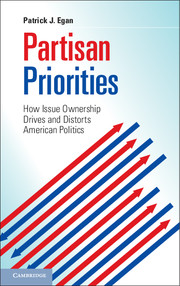Crossref Citations
This Book has been
cited by the following publications. This list is generated based on data provided by Crossref.
Banda, Kevin K.
2013.
The Dynamics of Campaign Issue Agendas.
State Politics & Policy Quarterly,
Vol. 13,
Issue. 4,
p.
446.
Egan, Patrick J.
2014.
“Do Something” Politics and Double-Peaked Policy Preferences.
The Journal of Politics,
Vol. 76,
Issue. 2,
p.
333.
Coffey, Daniel J.
2014.
Issue Ownership vs. Conflict Extension: Understanding State Party Polarization.
SSRN Electronic Journal,
Bélanger, Éric
and
Nadeau, Richard
2014.
Economic crisis, party competence and the economic vote.
Acta Politica,
Vol. 49,
Issue. 4,
p.
462.
Therriault, Andrew
2015.
Whose Issue Is It Anyway? A New Look at the Meaning and Measurement of Issue Ownership.
British Journal of Political Science,
Vol. 45,
Issue. 4,
p.
929.
Coffey, Daniel J.
2015.
The Moral Diversity of Polarization: Examining Intra-Party Philosophical Differences in a Polarized Political System.
SSRN Electronic Journal,
Walgrave, Stefaan
Tresch, Anke
and
Lefevere, Jonas
2015.
The Conceptualisation and Measurement of Issue Ownership.
West European Politics,
Vol. 38,
Issue. 4,
p.
778.
Ponder, Daniel E.
Simon, Christopher A.
Wendell, Dane G.
and
Tatalovich, Raymond
2015.
Public Opinion and Democratic Party Ownership of Prosperity.
American Politics Research,
Vol. 43,
Issue. 6,
p.
1107.
Banda, Kevin K.
2015.
Competition and the Dynamics of Issue Convergence.
American Politics Research,
Vol. 43,
Issue. 5,
p.
821.
Hines, Mark C.
and
Swers, Michele L.
2015.
Ideological Warriors and Constituent Servants: Understanding the Determinants of Participation on Health Care Legislation in the Polarized Senate.
Congress & the Presidency,
Vol. 42,
Issue. 2,
p.
147.
Christensen, Love
Dahlberg, Stefan
and
Martinsson, Johan
2015.
Changes and Fluctuations in Issue Ownership: The Case of Sweden, 1979–2010.
Scandinavian Political Studies,
Vol. 38,
Issue. 2,
p.
137.
Lefevere, Jonas
Tresch, Anke
and
Walgrave, Stefaan
2015.
Associative Issue Ownership as a Determinant of Voters’ Campaign Attention.
West European Politics,
Vol. 38,
Issue. 4,
p.
888.
Cobb, Michael D.
and
Taylor, Andrew J.
2015.
An Absence of Malice.
American Politics Research,
Vol. 43,
Issue. 6,
p.
923.
Graham, John D.
Rupp, John A.
and
Schenk, Olga
2015.
Unconventional Gas Development in the USA: Exploring the Risk Perception Issues.
Risk Analysis,
Vol. 35,
Issue. 10,
p.
1770.
Bélanger, Éric
and
Nadeau, Richard
2015.
Issue Ownership of the Economy: Cross-Time Effects on Vote Choice.
West European Politics,
Vol. 38,
Issue. 4,
p.
909.
Wagner, Markus
and
Meyer, Thomas M.
2015.
Negative Issue Ownership.
West European Politics,
Vol. 38,
Issue. 4,
p.
797.
Dahlberg, Stefan
and
Martinsson, Johan
2015.
Changing Issue Ownership through Policy Communication.
West European Politics,
Vol. 38,
Issue. 4,
p.
817.
Faricy, Christopher
2016.
The distributive politics of tax expenditures: how parties use policy tools to distribute federal money to the rich and the poor.
Politics, Groups, and Identities,
Vol. 4,
Issue. 1,
p.
110.
Bevan, Shaun
and
Greene, Zachary
2016.
Looking for the party? The effects of partisan change on issue attention in UK Acts of Parliament.
European Political Science Review,
Vol. 8,
Issue. 1,
p.
49.
Greene, Zachary
2016.
Competing on the issues.
Party Politics,
Vol. 22,
Issue. 6,
p.
809.



